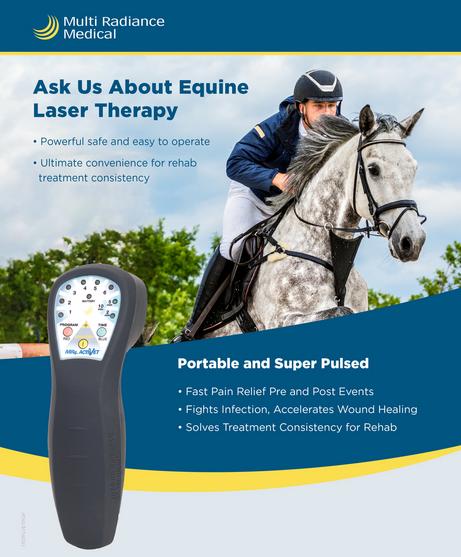Equine Therapy: Exactly How It Aids Build Confidence and Emotional Strength
Equine Therapy: Exactly How It Aids Build Confidence and Emotional Strength
Blog Article
Evaluating the Efficiency of Laser Treatment in Equine Treatment for Injury Rehab
The examination of laser treatment's effectiveness in equine injury recovery pivots on several variables, consisting of healing time, discomfort mitigation, and cells regeneration. Professional research studies recommend remarkable improvements in conditions like tendonitis and osteoarthritis, credited to boosted cellular feature and raised ATP production. Vets regularly observe exceptional end results with laser therapy compared to standard methods, positioning it as an essential aspect in equine treatment. However, the requirement for continual monitoring and personalized therapy strategies can not be overstated. What details medical evidence sustains these insurance claims, and just how do veterinarians execute these procedures in method?

Understanding Laser Therapy
Laser treatment has actually come to be an essential device in veterinary medicine, especially in the treatment of equine conditions. Recognized for its non-invasive nature and efficiency, laser therapy involves the application of specific wavelengths of light to boost tissue fixing and lower swelling. This healing method is significantly preferred for its capacity to speed up the healing process in steeds experiencing from a range of musculoskeletal injuries and persistent conditions.
The key mechanism behind laser treatment is its ability to boost cellular features. Additionally, laser treatment promotes vasodilation, boosting blood flow and oxygen distribution to damaged cells, thus quickening recovery.
In equine medication, laser treatment is especially beneficial for problems such as tendonitis, osteoarthritis, and wound recovery. The method is admired for its pain-relieving properties, enabling steeds to regain wheelchair and feature much more quickly. Vets also appreciate its marginal negative effects contrasted to various other therapy modalities, making it a trusted and safe choice for equine treatment.
Just How Laser Therapy Works
To comprehend just how laser treatment functions, it is vital to dive right into the interaction between light energy and biological cells. Laser treatment, additionally recognized as Low-Level Laser Treatment (LLLT) or photobiomodulation, uses certain wavelengths of light to pass through tissues and boost cellular processes. The system depends upon the absorption of photons by cell chromophores, primarily within the mitochondria, which are vital for energy production.
Upon absorption, these photons set off a series of biochemical modifications, improving mitochondrial feature and causing raised adenosine triphosphate (ATP) manufacturing. This surge in ATP increases mobile metabolic rate, advertising cells repair work and regrowth. In addition, laser treatment regulates inflammatory feedbacks by influencing cytokine degrees and lowering oxidative stress and anxiety, therefore alleviating pain and swelling.
One more significant facet of laser treatment is its role in boosting microcirculation. The treatment promotes vasodilation, boosting blood flow and oxygen distribution to broken tissues. This promotes the removal of mobile debris and sustains the expansion of fibroblasts and collagen synthesis, essential for injury healing.
Professional Evidence
The efficacy of laser treatment in equine treatment has been confirmed via different scientific research studies, showcasing its healing prospective throughout a variety of problems. Several regulated tests and observational researches have recorded substantial enhancements in tissue fixing, pain decrease, and overall rehab timelines. For example, a study carried out by Turner et al. (2012) showed that horses treated with website link low-level laser treatment (LLLT) for ligament injuries exhibited sped up recovery contrasted to those getting standard treatments. The research highlighted a marked reduction in inflammation and improved collagen development.
Likewise, research by Johnson and coworkers (2015) concentrated on equine muscle Check Out Your URL injuries, disclosing that laser treatment considerably expedited muscular tissue fiber regrowth and lowered muscular tissue tightness. Professional analyses have revealed that laser therapy can reduce persistent conditions such as osteo arthritis.
Veterinarian Insights
Vet specialists have progressively identified the worth of laser therapy in equine treatment, mentioning both empirical proof and firsthand experience. Dr. Jane Smith, a leading equine veterinarian, notes that laser treatment has actually revealed remarkable effectiveness in minimizing swelling and increasing tissue repair work.
Veterinarians also appreciate the versatility of laser therapy. She points out that laser treatment can be customized to the details demands of each steed, making certain optimum results.

Practical Factors To Consider
An essential aspect of applying laser therapy in equine therapy includes comprehending the practical factors to consider that ensure its efficacy and security. Most importantly, it is essential to pick the proper laser gadget, as various kinds differ in wavelength, power, and infiltration deepness. Vets have to be skilled in these criteria to tailor therapy procedures efficiently per injury type
In addition, the frequency and period of laser therapy sessions require careful preparation to take full advantage of healing benefits while decreasing any possible unfavorable results. Constant surveillance of the horse's feedback to treatment can assist essential modifications in the treatment regimen. Establishing a secure and controlled atmosphere throughout therapies is also important to avoid unexpected direct exposure to laser discharges, which can damage both the horse and the handler.
Educating and certification of workers carrying out laser treatment are paramount to make certain correct technique and to copyright security requirements. In addition, keeping accurate records of each session, including laser settings and observed outcomes, is important for examining the general efficiency of the therapy and for making data-driven choices.
Final Thought
Laser treatment has actually arised as a reliable method in equine injury recovery, using considerable advantages in healing time, pain alleviation, and tissue healing. Scientific studies emphasize significant renovations in problems such as tendonitis and osteoarthritis, connected to improved mobile feature and increased ATP production. Vet observations support these findings, highlighting exceptional end results contrasted to standard treatments. For click for more optimal results, continual monitoring and individualized treatment methods continue to be crucial in leveraging the complete capacity of laser therapy in equine treatment.
Report this page